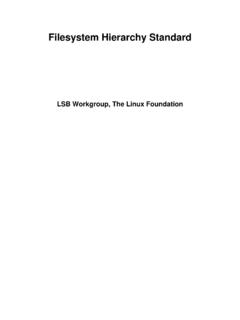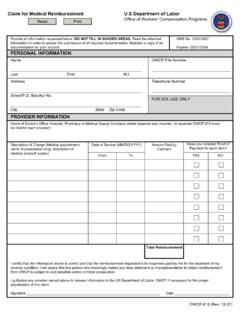Transcription of OECD GUIDELINE FOR TESTING OF CHEMICALS
1 301. Adopted: OECD GUIDELINE FOR TESTING OF CHEMICALS . Adopted by the Council on 17th July 1992. Ready Biodegradability INTRODUCTION. 1. In this GUIDELINE six methods are described that permit the screening of CHEMICALS for ready biodegradability in an aerobic aqueous medium. They are: 301 A: DOC Die-Away 301 B: CO2 Evolution ( modified Sturm Test). 301 C: MITI (I) (Ministry of International Trade and Industry, Japan). 301 D: Closed Bottle 301 E: modified OECD Screening 301 F: Manometric Respirometry Method 301 A is similar to the ISO Standard 7827-1984 and replaces the modified AFNOR. method; AFNOR has adopted the ISO standard.
2 Methods 301 B, 301 D and 301 E are modified versions of the earlier OECD Guidelines adopted in 1981. Method 301 C is virtually identical with earlier GUIDELINE 301 C (MITI I). Method 301 F is new; it is similar to 301 C differing mainly in the inocula employed. 2. Much experience has accumulated with the six methods over the years including an OECD. inter-laboratory comparison exercise (ring test) in 1988. The accumulated experience, and the ring test, have confirmed that the methods may be used for the assessment of ready biodegradability. However, depending on the physical characteristics of the substance to be tested, a particular method may be preferred.
3 3. General considerations including those common to all six methods are given hereafter. Details of individual methods are given under separate headings (301 A to F). Throughout the text the reader is referred to the Annexes which contain definitions (Annex I), formulas and useful guidance material. GENERAL PRINCIPLE OF THE TESTS. 4. A solution, or suspension, of the test substance in a mineral medium is inoculated and incubated under aerobic conditions in the dark or in diffuse light. The amount of DOC in the test solution due to the inoculum should be kept as low as possible compared with the amount of organic carbon due to the test substance.
4 Allowance is made for the endogenous activity of the inoculum by running parallel blanks with inoculum but without test substance, although the endogenous activity of cells in the presence of a chemical will not exactly match that in the endogenous control. A reference compound is run in parallel to check the operation of the procedures. 1/62. 301 OCDE / OECD. 5. In general, degradation is followed by the determination of parameters such as DOC, CO2. production and oxygen uptake and measurements are taken at sufficiently frequent intervals to allow the identification of the beginning and end of biodegradation. With automatic respirometers the measurement is continuous.
5 DOC is sometimes measured in addition to another parameter but this is usually done only at the beginning and end of the test. Specific chemical analysis can also be used to assess primary degradation of the test substance and to determine the concentration of any intermediate substances formed. It is obligatory in the MITI method (301 C). 6. Normally, the test lasts for 28 days. Tests however may be ended before 28 days, as soon as the biodegradation curve has reached a plateau for at least three determinations. Tests may also be prolonged beyond 28 days when the curve shows that biodegradation has started but that the plateau has not been reached by day 28, but in such cases the chemical would not be classed as readily biodegradable.
6 INFORMATION ON THE TEST SUBSTANCE. 7. In order to select the most appropriate method, information on the chemical's solubility, vapour pressure and adsorption characteristics is essential. The chemical structure or formula should be known in order to calculate theoretical values and/or check measured values of parameters, ThOD, ThCO2, DOC, TOC, and COD. Information on the purity or the relative proportions of major components of the test material is required in order to interpret the results obtained, especially when the result lies close to the pass level. 8. Information on the toxicity of the test substance to bacteria (Annex II) may be very useful for selecting appropriate test concentrations and may be essential for the correct interpretation of low biodegradation values.
7 APPLICABILITY AND SELECTION OF METHODS. 9. Test substances which are soluble in water to at least 100 mg/l may be assessed by all methods, provided they are non-volatile and non-adsorbing. For those CHEMICALS which are poorly soluble in water, volatile or adsorbing, suitable methods are indicated in Table 1. The manner in which poorly water-soluble CHEMICALS and volatile CHEMICALS can be dealt with is described in Annex III, but in the MITI method neither solvents nor emulsifying agents are to be used. Moderately volatile CHEMICALS may be tested by the DOC Die-Away method if there is sufficient gas space in the test vessels (which should be suitably stoppered).
8 In this case, an abiotic control must be set up to allow for any physical loss. 2/62. OCDE / OECD 301. TABLE 1 APPLICABILITY OF TEST METHODS. Test Analytical method Suitability for compounds which are: poorly volatile adsorbing soluble DOC Die-Away Dissolved organic carbon - - +/- (301 A). CO2 Evolution (301 Respirometry: CO2 evolution + - +. B). MITI (I) Respirometry: oxygen + +/- +. (301 C) consumption Closed Bottle (301 Respirometry: dissolved +/- + +. D) oxygen modified OECD Dissolved organic carbon - - +/- Screening (301 E). Manometric Oxygen consumption + +/- +. Respirometry (301. F). PASS LEVELS. 10. The pass levels for ready biodegradability are 70% removal of DOC and 60% of ThOD or ThCO2 production for respirometric methods.
9 They are lower in the respirometric methods since, as some of the carbon from the test chemical is incorporated into new cells, the percentage of CO2. produced is lower than the percentage of carbon being used. These pass values have to be reached in a 10-d window within the 28-d period of the test, except where mentioned below. The 10-d window begins when the degree of biodegradation has reached 10% DOC, ThOD or ThCO2 and must end before day 28 of the test. CHEMICALS which reach the pass levels after the 28-d period are not deemed to be readily biodegradable. The 10-d window concept does not apply to the MITI method.
10 The value obtained in a 14-d window would be acceptable in the Closed Bottle method if it is considered that the number of bottles necessary to evaluate the 10-d window causes the test to become too unwieldy. REFERENCE COMPOUNDS. 11. In order to check the procedure, reference compounds which meet the criteria for ready biodegradability are tested by setting up an appropriate vessel in parallel as part of normal test runs. Suitable compounds are aniline (freshly distilled), sodium acetate and sodium benzoate. These reference compounds all degrade in these methods even when no inoculum is deliberately added. It was suggested that a reference compound should be sought which was readily biodegradable but required the addition of an inoculum.

















